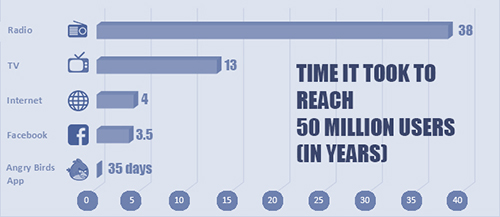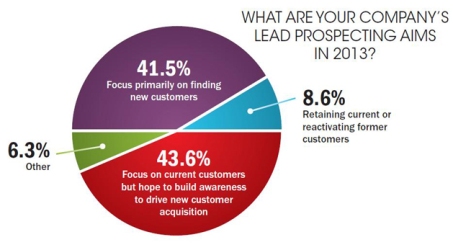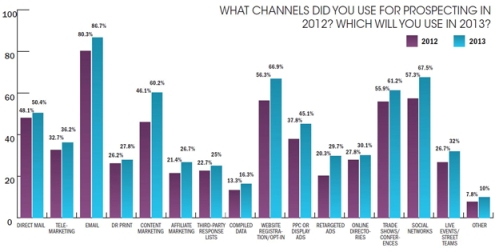Client Acquisition
B2B Marketing: A Fresh View on Client Prospecting

- Published: 06/04/2022
- (Revised: 02/02/2023)
- Reading time: 2 minutes
It is now clear that the B2B Marketing discipline has yet to reach a “New Normal” and probably will not get there soon. Disruption after disruption shuffles the effectiveness of doing B2B lead generation and client prospecting. Let’s review the market directions and how we should acquire new business clients today.

B2B Marketing Challenges
The marketing field is constantly evolving. What worked yesterday cannot necessarily deliver results today. The key element is to constantly gauge the effectiveness of your marketing strategies and tactics and ADJUST. Let’s take a bird’s eye view and identify first what are the multiple factors that influence marketing for businesses nowadays. Here are the 5 main challenges that are driving a sharp change in B2B Marketing:
- Influx of information and buying options – With over 200 million active websites and over 3.5 billion Google searches per day (Internetlivestats), the purchasing decision is becoming more complex every day and the B2B buyers are overwhelmed by the amount of data they need to process and validate. This makes the buying journey complex, non-linear, and thus, involves more decision-makers in the process (see Gartner’s typical buying journey below).

The B2B customer journey is no longer linear or straightforward (Gartner)
Decreasing buyer’s attention span – A recent study by the Technical University of Denmark indicates that the abundance of information is narrowing our collective attention. This does not mean that humans lose concentration after 8 seconds, as was previously suggested. Instead, B2B buyers are now highly selective with their time allocation when it comes to content. Due to their limited resources, they will only focus on high-quality, reliable, and riveting content (Note: We hope that you will reach the end of this blog to learn new ways to conduct business client prospecting).
Low B2B buyer’s trust in vendors – When making a purchase decision, B2B buyers have lots at stake and thus they crave trust. B2B buyers often look to build a relationship with a vendor that instills strong confidence and their deliverables will yield positive business outcomes (i.e., address the challenges their organization faces effectively). Nevertheless, research results from Forrester and Edelman show a widening gap between how B2B clients perceive vendor providers and how vendors grasp their own reputation. See the diagram below regarding your specific industry sector.
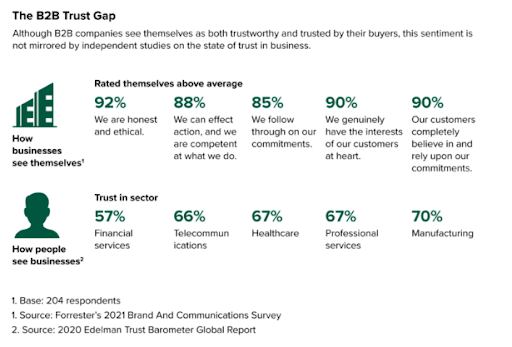
The B2B buyer’s trust perception is much lower than how vendors believe their actual trust level.
- The loss of physical selling – It is evident that the COVID-19 pandemic forced us to give up on the very few in-person marketing interactions that were still viable. Conferences turned into virtual events and sales reps’ meetings are now mostly through chats, video conferencing, or phone (if required). McKinsey & Company demonstrates this change in the below diagram.

70-80% of interactions of B2B sellers are digital (remote or self-serve)
- The rise of the millennial buyers – As you might know, the global workforce today consists mostly of the millennials generation (1981-96) workers. Generation X (1965-80) is still occupying some management positions.
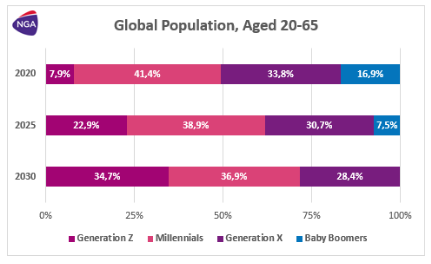
Generation millennials and generation Z are shaping the B2B buyer characteristics (NGA/LinkedIn – Anita Lettink)
In just another decade, generation Z (1997-onward) is threatening to take over with millennials being mostly in management positions. Thus, it is critical to understand the unique characteristics of these generations.
For these generations, online search is the first step in researching a B2B solution. Digital interaction is the preferred client prospecting method with an emphasis on convenience and availability. Thus, mobile interaction is taking a stronger part, as it is a speedy way to gain knowledge whether through quality content or interaction with social friends/reviews, not with sales representatives.

What's Your MarketingReadyTM Ranking?
The table below explains the shift in the buyer characteristics (by generation):
| Area | Millenials | Generation Z | Trend Impact |
|---|---|---|---|
| Values | Convenience & flexibility | Product quality & availability | Client experience is above other vendor features, including product quality |
| Purchase | Impulse buying | Browse online and then in-store | Easy and immediate access to vendor data |
| Device for purchase | Desktop & mobile | Mobile | Unique preferences on how and when they want to interact with vendors during the sales process |
| Shopping Experience | Personalized & traditional | Customization & crowdsourcing | Expectations for personalized sales and marketing outreach |
| Social Channels | Facebook & Instagram | Snapchat & Instagram | High reliance on the perspectives of family, friends, and acquaintances |
Sources: Pew Research & Direct Objective Consulting
Achieve Growth with Practical Tactics
To address the above challenges we would like to show you how incorporating the correct B2B marketing strategies or lead generation tactics will yield the business growth that you are looking to gain. While the above-listed challenges are interconnected and certain strategies and tactics can address multiple objectives, our exercise below will only demonstrate a few examples of adjusting or adding certain B2B marketing strategies/tactics that in turn will derive a strong impact on your business growth.
Too Much Information Out There – How Can I be Found Out?
Gartner’s research finds that when B2B buyers are considering a purchase, they spend only 17% of that time meeting with potential suppliers. In fact, this is because 33% of all buyers desire a seller-free sales experience – a preference that climbs to 44% for millennials, which is in line with the above McKinsey & Company findings.
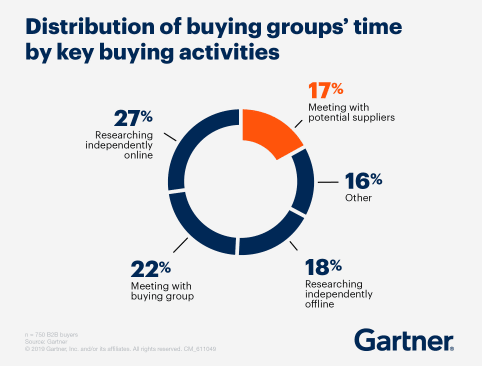
How B2B tech buyers split their time during the buying process (Gartner)
When you realize that your website is no longer the center of the world for your potential buyers, it means that your B2B marketing must also invest in external properties so that you will be able to drive back prospective clients to your website. Here are a few ideas to assist you in doing it:
- Search Engine Optimization (SEO) – Invest in having your web properties dominate the first page of highly searched key phrases/ keywords. Make sure you are found in the most relevant keywords. Most buyers will not go beyond the second page.
- Influencers Marketing – Let industry experts, opinion leaders, and technology analysts recognize the value of your solution. Prospective clients are looking to rely on 3rd party opinions.
- User-generated Content – A strategy that would entice or facilitate client involvement in creating content such as increased social media presence, solution reviews, or media coverage about your client’s success will allow potential customers to receive additional confirmations that are external to your website
Replacement of the Physical Selling
As most clients are leaning first toward a seller-free buying environment, B2B marketing’s role is to identify who is really interested in your solutions, expose them to a content that would engage them and based on their level of engagement decide which client (account) to pursue further.
The following examples demonstrate this strategy:
- Highly-Engaging Content Development – Create quality content with great relevant value to your future clients and by that gain authority in your field and client engagement. Content comes in various forms, for example, an interactive webinar about a hot topic, a buying checklist document, or a brief insightful video. The type of content must match the buying stage of the prospect. In the diagram below, you can see B2B content assets that produced the best B2B lead generation results based on a 2021 survey of MarketingProfs and the Content Marketing Institute. Remember, it’s the quality of the content and the matching into the buying stage that matters!
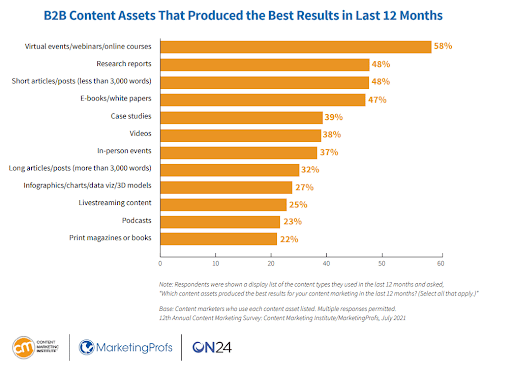
- In-Market Intent Data – As prospective clients are conducting research first with third-party resources, such as online events, industry newsletters, solution directories, review sites, and many other sources, these third-party collect data (with consent) about buying intents of various organizations. This intent data indicates who is likely to be in-market for your solution. Having the ability to narrow down who’s looking for your solution will enable you to reach higher conversion rates than the traditional advertising approach that broadcasts to all potential clients without knowing if they have the intention to buy or not.
- ABM/ABX and Marketing Automation Tools – Using sophisticated tools, you will be able to identify the contacts that are part of the buying decision committee and bundle them all under one account – this strategy is called Account-Based Marketing/Experience (ABM/ABX). Analyzing the level of engagement of the combined contacts within the account will provide you signals on whether this account is ready to be handed into the sales team or further nurturing is needed to build trust, knowledge, and engagement. Martech (Marketing Technology) is a set of practical tools that allow you to gain insights regarding prospective client behavior and then support semi-automated decisions on how to advance accounts toward a purchasing decision.
The Traditional Sales Process is Broken – What do I Offer as an Alternative?
While it is important to maintain a sales-free environment at the early stages of the buying process, the sales team has a critical role throughout the middle or bottom of the sales funnel. The new role of the salesperson is to validate the sales opportunity, identify the obstacles that prevent clients from making decisions, and facilitate the buying decision by providing critical content that will tip the decision toward your solution.
Another strong trend that we see the market evolving into is a high demand for a self-service environment that minimizes the interaction with people. Instead, implement sophisticated chatbots and well-designed websites that walk the prospects through a process where they receive information for every little interaction they do. Each potential client receives a personalized experience that satisfies their specific needs. If this process is well-thought, you can even offer a B2B ecommerce site that shortens the sales cycle and enables you to better customize and support the experience of the millennial and generation Z B2B buyers.
B2B Marketing and lead generation have evolved into a complex integrated process where sophistication, automation, and tactic integration are key to success. Continuous measurement provides you the ability to constantly adjust, improve and surpass previous results, leading your business to high growth.
If you would like to see how the new directions in B2B marketing apply to your organization, please do not hesitate to contact us for a consultation session.
Testimonials
“Ranking our Web site high on search engines results, designing a professional Web site look and developing engaging relevant content for a heavy technology company like us resulted in a dramatic increase in client leads that we receive from our Web site.”
Simon Robin CEO, Hardent







